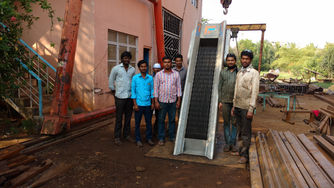
Mechanical Step Type Screen
Reliable Fine Screening Solution for Sewage and Effluent Pretreatment

Overview
Fundametal’s Mechanical Step Screen is a rugged, self-cleaning fine screen designed for high-efficiency solids removal at the inlet of sewage and effluent treatment systems. Its unique stepped lamella arrangement and CAM-aided motion deliver smooth, automated operation with minimal operator intervention. The design ensures long-term performance and low lifecycle costs, even in harsh effluent conditions.
Whether used in municipal STPs or industrial ETPs, this screen provides effective preliminary screening that protects downstream equipment and enhances overall process stability.
Working Principle
The Step Screen operates using two interleaved sets of lamellae—one fixed and one moving—arranged in a stair-step formation. As wastewater enters the channel and flows through the screen, solids accumulate on the lower steps. When the upstream water level reaches a set point, the drive system activates the moving lamellae.
These lamellae follow a distinctive CAM-guided motion path: an elongated horizontal sweep followed by a vertical lift. This mushroom-head-shaped motion gently transports accumulated screenings upward, step-by-step, to the discharge area. As solids are lifted, new flow surfaces are exposed, allowing continuous operation without brushes, sprays, or manual intervention.
The geometry of this movement creates a carpet-like mat of screenings—a desirable feature for process engineers aiming to optimize fine solids removal. The mat improves filtration performance beyond the nominal bar spacing and enhances retention efficiency under variable loading conditions.
Drive & Transmission System
The Step Screen is powered by a chain and sprocket arrangement that serves exclusively as a transmission element to the CAM system. While not entirely free from submergence, the majority of the chain, sprockets, and CAM mechanism components are positioned higher up in the process flow. This minimizes their exposure to raw sewage and potential fouling.
All transmission elements are housed in a sealed, protective chamber. This enclosure isolates mechanical parts from fibrous and abrasive material present in wastewater. Where needed, the enclosure can be fitted with a service water line to maintain positive internal pressure—further reducing the risk of ingress and ensuring long-term operational stability.
Materials & Wear Elements
All structural and wetted components of the screen are built using rationalized corrosion-resistant materials. Standard configurations are fabricated entirely from stainless steel (typically SS304 or SS316), providing excellent durability in most sewage and effluent applications.
For aggressive environments—such as coastal installations or plants handling high chloride effluent—advanced material options like duplex stainless steels, Titanium Grade 2, or copper-nickel alloys (CuNi 70:30 or 90:10) are available upon request. These special materials are selected for their enhanced corrosion resistance, long-term structural integrity, and lifecycle cost efficiency.
The moving and fixed lamellae are interspaced with precision-machined UHMWPE (Ultra-High Molecular Weight Polyethylene) spacers. These wear-resistant components ensure smooth, low-friction operation by eliminating metal-to-metal contact. They also help maintain accurate alignment during movement, reduce mechanical noise, and absorb vibration—contributing to a quieter, longer-lasting machine.
Performance & Lifecycle Benefits
One of the key differentiators of Fundametal’s Step Screen is its stroke length. Each movement transports debris by as much as 160 mm—significantly longer than most conventional step screens. This allows efficient solids conveyance with fewer cleaning cycles.
Importantly, the stroke is executed while keeping step height below 20 mm. This careful balance results in enhanced solids removal efficiency without excessive turbulence or energy draw.
The CAM-aided movement, in conjunction with UHMWPE-guided lamellae, provides a mechanically gentle but highly effective screening action. The low-speed operation helps extend the life of key components, reduces wear, and lowers energy consumption. While the formation of a screening mat may cause a modest rise in upstream water level, this is a known trade-off among step screens—one generally considered acceptable given the superior screening performance it enables.
Overall, the screen delivers excellent operational economy, low maintenance burden, and robust reliability under variable hydraulic conditions.
Applications
Fundametal’s Mechanical Step Screen is suitable for a wide range of inlet screening duties, including:
-
Sewage treatment plant Pretreatment Units
-
CETPs and industrial ETPs (textile, paper, food, pharma, chemical)
-
Compact or retrofit civil structures where Headroom above the channel is constrained
Why Choose Fundametal
Fundametal Technologies designs each Step Screen with durability, reliability, and site-specific performance in mind. Our focus is on mechanical resilience and easy maintenance, rather than over-engineered complexity. We offer full engineering support to help clients select the right configuration based on hydraulic load, channel dimensions, and process objectives.
All screens are built to order using precision fabrication processes, traceable materials, and factory-run testing. We provide optional add-ons such as safety covers, screening compactors, level-based automation panels, and site commissioning support.
With proven installations across India and an unwavering focus on practical engineering, Fundametal’s Step Screens offer long-term performance, low lifecycle costs, and peace of mind for plant operators, consultants, and EPC contractors alike.
Product Demo
Image Gallery








